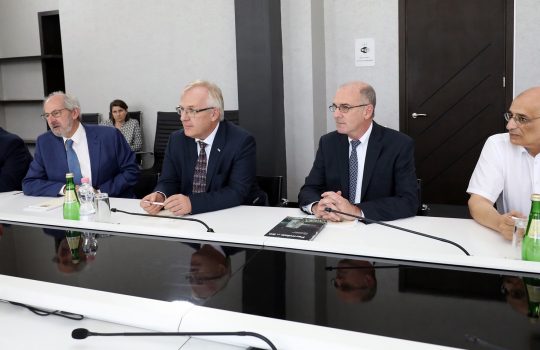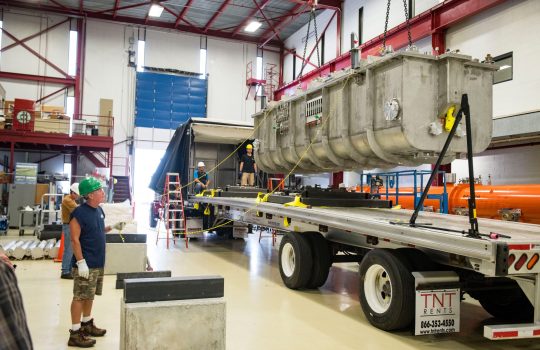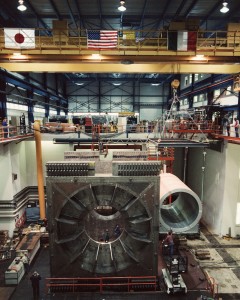
This photo, taken in 1984, shows the Japanese, United States and Italian flags flying over the CDF detector. Photo: Fermilab
The nation that gave the world superstar physicists Enrico Fermi and Ettore Majorana also sent 100 scientists to Fermilab to work on the CDF experiment in the 1980s. They, along with their colleagues on the CDF and DZero experiments, would go on discover the top quark, scoring another mark for Italy’s contributions to particle physics — and sowing the seeds of a fruitful partnership with America’s particle physics laboratory.
Italy is Fermilab’s strongest partner country, with the largest number of collaborators, students and staff members of any nation outside the United States. It is also Fermilab’s second-largest international user community by institution and one of the longest-standing at the lab, with roots in the early Fermilab experiments of the 1970s.
The CDF partnership began in 1980, when scientist Giorgio Bellettini reached an agreement with Fermilab and Japan to formalize a three-country collaboration on the experiment. In 1981, CDF consisted of 16 scientists from Italian institutions, 15 from Japanese institutions and 56 from American institutions. Three flags hung above the detector.
“CDF was a three-nation endeavor,” said Bellettini, who was co-spokesperson from 1995-97 and is the experiment’s current co-spokesperson.
By 1991, participation by users from Italian institutions on CDF more than quintupled: About 100 users were working on the Tevatron experiment in Run 2.
“There was an explosion of Italians here,” Bellettini said. “Those long roots built during those years have split now into a number of branches.”
The branches today reach into all areas of particle physics. Fermilab users from Italian institutions continue to work on collider physics at CDF and at the Large Hadron Collider’s CMS. They work on neutrinos through the NOvA, ICARUS and LBNF/DUNE experiments; muon physics through the Muon g-2 and Mu2e experiments; and dark matter through the lab’s collaboration on the DarkSide experiment.

In 2014, Nigel Lockyer, left, recognized Fermilab scientist Giorgio Bellettini for “his 35 year dedication to science at Fermilab and for being instrumental in bringing a large international community to the Tevatron program.” Photo: Cindy Arnold
Italian scientists and engineers contribute to new and better accelerators through the laboratory’s accelerator R&D programs. And Italian theoretical physicists at the lab work on lattice QCD and computer simulation.
The numbers reflect Italy’s strength in Fermilab life. In 2015 Fermilab hosted 133 scientific users from 40 Italian institutions on 19 different projects or experiments. Sixty users worked remotely; 73 worked on site.
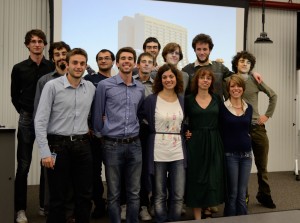
Every summer 20 to 30 graduate students from Italian schools come to Fermilab to conduct R&D for the laboratory’s various projects. Emanuela Barzi, a member of the Technical Division and the Italian community at the laboratory, is in the front row, second from the right. Photo courtesy of Emanuela Barzi, TD
And sometimes those who come to Fermilab to do research decide to stick around.
“If you go through the Fermilab telephone directory, you will find 30 or 40 Italian physicists or engineers who started as visitors from INFN institutions and either became lab employees or became employed by an American organization affiliated with the lab,” Bellettini said.
The Instituto Nazionale di Fisica Nucleare is the funding agency for high-energy physics in Italy, and today most of Fermilab’s scientist-user agreements are conducted through INFN.
Part of the reason for the enduring relationship is that the Fermilab Italian community recruits promising students to work at the lab. In 2015, a record number of 31 graduate students worked on Fermilab projects in the summer. Since 1984, the Cultural Association of Italians at Fermilab, supported by INFN, has sponsored a summer student program at the laboratory, bringing in 20 to 30 physics and engineering graduate students every year.
“These young Italian graduates are so well-prepared that most of them leave their mark at the lab even in just the couple of months of their internship,” said Emanuela Barzi, a particle physicist and nuclear engineer in the Technical Division. Barzi has been an active member of the Fermilab Italian community for 20 years. “A number of us Italians at the lab keep close collaborative ties with our creative counterparts in Italy. It enhances our scientific outcome.”
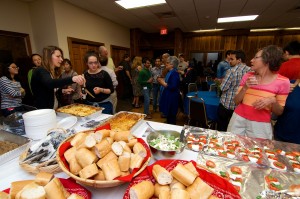
The Cultural Association of Italians at Fermilab and the Fermilab Users Organization organizes Festa Italiana every year. Photo: Leonardo Ristori, TD
For Bellettini, the students’ contribution goes beyond science.
“They contribute, they learn — it’s a privilege to be here,” Bellettini said. “The Italian flavor you find here today is in good part due to the students. They’re here for only two or three months, but they come back. Their style leaves an impression.”
One of the enduring marks of their style is Festa Italiana, hosted by the Cultural Association of Italians at Fermilab and the Fermilab Users Organization. Hundreds of people regularly turn out for the highlight event of the annual Users Meeting to enjoy good company, good times and heaps of food — and it’s science that brings them together.
“I just became American, and I’m still proud of my Italian origins,” Barzi said.
This is the first in a series of occasional articles on countries that partner with Fermilab.

